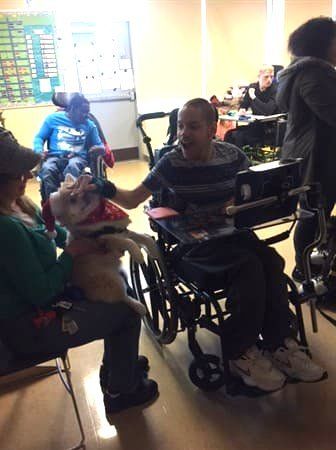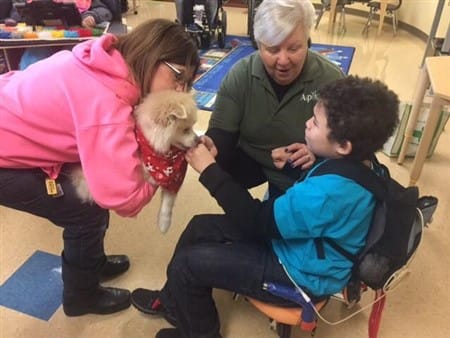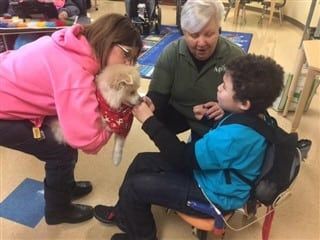Pomeranian Therapy Dogs
Overview
You may have heard about therapy dogs; but, did you know that the Pomeranian can be fantastic at this sort of work? It does require an outgoing personality, and the ability to remain calm and happy in busy situations; however, some Poms are a good fit for this.
In this section, we’ll take a look into what is involved with this, and then meet a very special Pomeranian that works as a therapy dog in a variety of settings.
Please note:
PetPom is reader-supported, and some of the product suggestions on this page are affiliate links. As an Amazon Associate we earn from qualifying purchases. This is at no extra cost to you and helps keep this site running.
What are Therapy Dogs?
The idea of therapy dogs was started in 1976 by a registered nurse named Elaine Smith. While at work, she noticed that when a chaplain and his Golden Retriever visited the hospital, patients responded wonderfully.
Seeing that, she started a small program to have volunteers and their dogs spread cheer. It began with just 5 handlers and 6 dogs. Her efforts grew into Therapy Dogs International, which now has over 24,000 human and dog teams.
The AKC recognizes 150+ therapy dog certification organizations; when a dog receives certification through one of those programs, he earns his AKC Therapy Dog title.
All therapy work is on a volunteer basis, to bring comfort and affection to others. The most common settings for this are hospitals, nursing homes, hospices, and areas that are recovering from natural disasters. Therapy dogs may also go to schools to visit children.
In some states, programs are being developed to bring therapy dogs into new settings. Once such program, that we will hear more about in this article, is bringing therapy dogs into airports to help stressed out passengers.
Meet This Wonderful Pomeranian Therapy Dog
This is Kody Bear, a Pomeranian that has been a therapy dog for about one year now.

He is a certified therapy dog through the SPCA’s Paws for Love program
in Erie County, New York state.
Let's Get to Know about Kody Bear, with Some Q&A
Kody Bear's owner, Marilyn Wetter of Getzville, NY, was kind enough to answer our questions about her Pomeranian and about the type of therapy work that he does.
Q: When did you decide to have your Pomeranian train to be a therapy dog? And what gave you the idea to do this?
A:
Kody Bear is the first dog that I ever got as a puppy. We had previous adult dogs, one adopted from the SPCA (Buffy, a Pomeranian that made us fall in love with the breed), and one from an online ad for a Pom that needed to be re-homed (Destiny).
When Destiny passed, my husband wanted us to try getting a larger Pomeranian - a puppy! I saw an ad in the local paper and found a very loving local hobby breeder who was just looking for good homes for the puppies she had. They happened to be larger Poms.
Kody Bear was chosen by us for his beautiful eyes and calm personality. Since he was my first puppy ever I read many books and watched many training videos and was so proud at how smart he was and how I could get him to listen to me. I kept him from barking
on walks no matter what we ran in to (treats in my pocket always).
Being recently retired when we got him I had the time to train him and wanted to be able to take him places and spread joy.
That’s when I saw the information on the SPCA’s Paws for Love Program during an online search.
Q: Kody Bear has earned his SPCA therapy certificate. Can you tell us what was involved in training him to earn this? And, what was involved in the actual testing for this?
A:
Volunteers and pets are evaluated by certified animal behaviorists and if they pass are put directly in touch with facilities requesting visitations.
The dogs must be very responsive to their owners. Kody Bear needed to be able to listen to me when I commanded him. They had me walk in the room with him, I told him to sit then stay and wait. He waited even with a treat
on the floor. They have other people come in the room with wheelchairs, walkers, some wearing hats, they even bring in another dog.
If your dog reacts appropriately by listening to you - he passes :) They test him as to how he takes treats from strangers too. Kody is best with an open hand for treats. I also had him do tricks (because he's so smart) paw, other paw, dance :) Kody Bear passed with flying colors!
Q: For the therapy training, were there any parts that Kody Bear had to train extra hard for? What parts came easy and natural to him?
A:
Kody Bear didn’t have any extra special training for his ‘job’ as a therapy dog. He is friendly, loves people and gives lots of kisses to everyone. He was born as natural therapy dog!
Kody Bear and student Trevon saying hello to eachother
at the Aspire Center for Learning
Editor's Note:
Aspire's Center for Learning
strives to support to those with developmental disabilities in WNY, offering early intervention services for babies and toddlers up to 3-years-old (at home or in community settings), preschool for 3 to 5-year olds, comprehensive classroom settings for students for ages 5 to 21 years old, and even summer internship programs.
Q: What sort of places do you bring Kody Bear? We’d love to hear more about what sort of places he goes/has gone.
A:
Kody Bear and I started our visitations in May 2016 when he was almost 2 years old. I love animals so much that I started working as an Independent Contractor for Laura's Critter Care, a local pet sitting company in 2013, so I fit therapy visits in where I can in between caring for other people’s pets while they were at work or away on vacation.
I decided to try and stay close to home for therapy visits and became a regular at an assisted living facility in our neighborhood.
We have gone to elementary schools, colleges for stress relief, and have visited the classrooms of Aspire Learning Center to spend some time with developmentally disabled children and young adults.
Airport visits are done as stress relief for travelers who need a furry friend for comfort.
-min-338x450-1920w.jpg)
Kody Bear volunteering at the Buffalo/Niagara International Airport
Editor's note:
Airport therapy dog programs were first implemented after 9/11 to help passengers that were very jittery. Now, over 20 airports around the US have evolved this into tasking therapy dogs to help make airports a more pleasant experience. The dogs work to de-stress those waiting in line, and calm those who are feeling anxious about flying.
Aside from where Kody Bear works in New York, some of the airports that have therapy dogs come in are LAX, Reno-Tahoe International Airport, Fort Lauderdale-Hollywood International Airport, Mineta San Jose International Airport
Q: How often do you take Kody Bear to do therapy work? And typically, how long does each visit last for?
A:
I try and go 4 to 5 times a month. We get many emails from the SPCA from places looking for visits from therapy dogs. Whenever I can fit new places in for visits I sign up - sometimes there are no spots left – that’s how responsive the volunteers are!
It’s awesome to see and be a part of this wonderful program. The visit times last anywhere from 30 minutes to two hours. It all depends on what is going on at the facilities and how many participants there are and, of course, how tired Kody Bear may get from giving so many kisses.
-min-336x450-1920w.jpg)
Kody Bear saying hi to Sami, a student at Aspire of WNY
Q: We can imagine that therapy work and making people’s day a bit happier is extremely rewarding, for both you and Kody. Can you tell us more about this aspect?
A:
Unfortunately, some people do not get any visitors or hardly any and Kody Bear makes them so happy. The staff at the various facilities let us know how much we make their day.
I was told that one child never smiles - that is until he met Kody Bear! It brings tears to my eyes for sure!

Jacob, a student, and Kody Bear greeting eachother at the Aspire Center for Learning
Q: You have another Pom, little Bella Mia, whom you rescued in 2016. Do you think that she will also do therapy work when she is older?
A: My little Bella Mia - she is actually six years old. I am not sure that I will have her do therapy work like Kody Bear. I do take both of them shopping to stores that allow dogs.
I put them in the shopping cart and people stop me and comment how cute and how good they are. I always let them know that Kody Bear is a therapy dog and that they can pet both dogs. Bella Mia is very good but gets a little nervous and keeps her eyes on mommy. She knows she gets some kibble every time someone pets her and she loves that :)
-min-338x450-1920w.jpg)
Kody Bear and Bella Mia, happy to be out at the store
Q: What would you say are the top benefits to having your dog be a therapy dog?
A:
Being a volunteer means that you can do therapy at your convenience when you have time. It is so rewarding for you but so much more for your dog. Many dogs like to have jobs; they need stimulation and to have a purpose.
Dogs that are busy are happier and healthier. A lot of people will say their dogs just want to sleep and eat – that’s because they are bored. Believe me, you will have a happier dog if he has a ‘job’ of his own.
Editor's note:
Marilyn is spot on that Pomeranians are indeed happy when they do more than just 'be there'. And while therapy work is great, there are lots of other activities you can do too! Pomeranians love all sorts of things.
Make sure you have a safe car seat for your Pomeranian, and depending on where you are planning to go, a comfortable carry method like the i'Pet Hands-free Small Dog Sling Carrier Bag
 which keeps him right up by your hip without you having to hold him, or a stroller that keeps him safely off the ground (and able to go where there are large crowds like the New Blue 4 Wheel Pet Stroller by BestPet
which keeps him right up by your hip without you having to hold him, or a stroller that keeps him safely off the ground (and able to go where there are large crowds like the New Blue 4 Wheel Pet Stroller by BestPet , and then head out with your Pom.
, and then head out with your Pom.
Go to stores, malls, flea markets, farmer's markets, fairs, orchards, and other places that bring about new sights, sounds, and experiences. It helps your Pom be better socialized, and can be a lot of fun for both of you.
At home, take the time to teach your Pom some commands, and be a partner with him to do some fun learning games such as puzzle toys. You can even give him some jobs such as putting his toys away or playing 'find it' with them.
Q: What advice would you give to other Pom owners who may be interested in having their Pomeranian become a therapy dog?
A:
Check your local SPCA for information on these types of programs. First train your dogs to be good around other people. It’s easiest and best to train right away when they are puppies - maybe to take them to puppy kindergarten (Kody Bear did that) and then socialize them a lot!
They need to see people of all different races, they need to see people wearing coats, hats, etc. They need to be around children - crying, laughing, and running (of course safely due to their size).
A huge thanks to Marilyn
for letting us get to know about her super cute Pomeranian therapy dog. We are sure that you agree that the volunteer work that she does with her Pom is truly inspiring! Thank you Marilyn, for your heartwarming service and for allowing us a peek into your world.
And a big thanks to Kody Bear for being such an awesome volunteer and a wonderful friend to everyone that he meets.
If You Think Your Pom Might Be a Good Therapy Dog
Not all dogs are cut out for this sort of work.
And that is perfectly okay!
A very calm yet friendly and outgoing personality is needed for therapy work, among other things.
Many Poms are a bit too shy to encounter so many different people, and part of the testing is to remain calm amidst chaotic scenes such as people dropping things, yelling, and other disturbances.
Even remaining in place in a 'stay' and resisting a treat is part of the testing. In some cases, dogs are not allowed to take a treat even when someone is waving it right in front of them.
While not all organizations require this, with Therapy Dogs International, dogs are never allowed to mouth anything given to them by those that they visit, to prevent any sort of accidental poisoning - medications, etc.
But, if you think that you might want to see if your Pom could do therapy work, you'll:
1)
First want to be sure that he's spot on in regard to knowing all basic commands. Canine therapy organizations test dogs on commands, but do not train them for them.
If you want to teach your Pom commands and all sorts of fun and amazing tricks, you might want to check out 101 Dog Tricks: Step by Step Activities to Engage, Challenge, and Bond with Your Dog . Or, for guided in-person training, contact your local SPCA and sign up for a class.
. Or, for guided in-person training, contact your local SPCA and sign up for a class.
2)
Then, to find out more, you may wish to visit the AKC's page that lists out all of the therapy programs
that they recognize (which links out to them).
Or, you may wish to learn a bit more by visiting the Therapy Dogs International website.
You May Also Like:
Pomeranian Puppy Teething
- What to expect, and effective ways to deal with this phase. Also covers chewing issues for Poms of all ages.
Pomeranian Separation Anxiety
- How to help your Pom cope when home alone.





